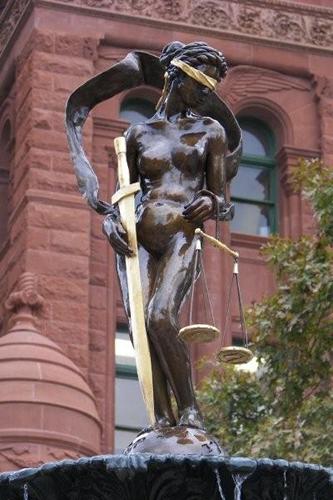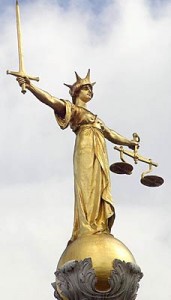 This last month the New York Times published an op-ed piece stating that President Obama’s “administration and the Senate leadership should pick up the pace of nominations and confirmations in order to restore some balance to a federal judiciary that was pushed sharply to the right by former President George W. Bush.” * A few days prior to this National Public Radio (NPR) had an unrelated piece about a newly published book on Supreme Court Justice Antonin Scalia. The title of the NPR article was “Scalia Book Explores the Man Behind The Justice” and one glance at included excerpts of the book’s Prologue reveals that his judicial spirit is very much also the jousting spirit mentioned in Mythfire‘s last blog:
This last month the New York Times published an op-ed piece stating that President Obama’s “administration and the Senate leadership should pick up the pace of nominations and confirmations in order to restore some balance to a federal judiciary that was pushed sharply to the right by former President George W. Bush.” * A few days prior to this National Public Radio (NPR) had an unrelated piece about a newly published book on Supreme Court Justice Antonin Scalia. The title of the NPR article was “Scalia Book Explores the Man Behind The Justice” and one glance at included excerpts of the book’s Prologue reveals that his judicial spirit is very much also the jousting spirit mentioned in Mythfire‘s last blog:
“With his biting humor, Scalia has been advancing the legal theory known as “originalism” — insisting that judges should render constitutional decisions based on the eighteenth-century understanding of the text. “It’s a fight worth making,” he says in remarks that are part battle cry, part assertion of victory.” **
The Prologue also observes how Justices Alito and Roberts “have long admired Scalia and the way he wages the good conservative fight.” Scalia sounds like he’s part court justice and part court jouster. (And, yes, the excerpts also exhibit elements of the court jester in Scalia as well).
It is, of course, no revelation that judges are biased human beings like the rest of us. Every time a new Supreme Court Justice must be nominated and appointed, the question most prominently on people’s minds is “will she or he move the court in its entirety to the left or to the right?” The recognition of personal bias, of “the man behind the justice,” has no doubt made itself known in harmful as well as relatively harmless ways over the centuries. The tension between eternal ideals (what is called “the spirit soul” in previous blog entries) and the emotional exigencies of specific real-life situations (“the blood soul”) plays out in “the men and women behind the justices” just as they do within and between other individuals and the cultures they inhabit.
The last blog entry suggested that in such states of opposition a symbol often emerges and takes its place in the cultural imagination or psyche in such a way that is meant to transform and thus resolve the previously existing tension. In terms of the idea of justice and its inherent tensions (i.e. spirit vs. blood soul, good vs. evil, truth vs. falsehood, etc.), the symbol that arose and furthermore has retained its symbolic power up to the present day is that of the Goddess Themis. The present entry takes a quick & closer look at several aspects of the imagistic power of Themis and her accoutrements: blindfold, sword, and scales. At the same time, Mythfire looks at how these images might apply to the Roman Polanski case that is currently in the news.
 First, a symbolic primer:
First, a symbolic primer:
Blindfold: the impartiality of the law (justice as blind to differences between opposing parties); the idea that “nothing but pure reason, not the often misleading evidence of the senses, should be used in making judgements”***; inner withdrawal and contemplation; insight
Sword: that which, using the power of discrimination, separates true from false, good from evil, and in so doing
(re-)establishes right order; the power of creation as well as destruction; the instrument of decision and active truth
Scales: the capacity to hold opposite ideas and energies in balance; justice, moderation, prudence, and balance resulting from the weighing of actions and activities; when imaged with the sword, scales symbolize Justice in double harness with Truth
A proper analysis of these symbols along with their application to the subject at hand would include multiple examples both verbal (i.e. myths, fairy tales, folk tales, legends, etc.) and visual (like that to the right) in which these images are on display in a manner that supports the primary symbolic descriptions just bullet-pointed. However, for the sake of blogging brevity, this evidentiary stage of academic argumentation will be put to the side in this entry.
On to the next disclaimer: Mythfire will put questions to the reader below, asking readers to act as if they are the judge or the jurors in the Polanski case. (Indeed, it does seem that as of this writing, Polanski may end up before either a judge or both a judge and jury****). Regardless, the idea is that whether as a judge or a juror, we begin by imaginally retreating into the jury deliberation room, the judge’s chambers within our mind and put around our own eyes the blindfold of impartiality.
The jury deliberation room and judge’s chambers symbolize a container in which the opposites of spirit-soul and blood-soul can be held (or contained) until a resolution is found. Whether physical or psychical (i.e., the jury/judge’s room in our mind’s eye), it is in this space that the “weighing of actions or activities” – represented by the scales – and the process of separation and discrimination (the sword) can take place.
However (and herein lies the second disclaimer), can we truly be sure that we know exactly all of the actions and activities pertaining to the Polanski case? At present, the case is being tried in the court of public opinion, a hole-filled sieve-like container if ever there was one. Mightn’t there be more in the way of actions and activities regarding the various aspects of the Polanski case than have been disclosed up to now? Isn’t it possible that the documentary film as well as the various news reports have either unintentionally or even intentionally left out details that concern Polanski’s culpability, the original judge’s impropriety, or other relevant matters?
In keeping with the symbol of the scales, it would seem quite imprudent and even unjust, then, for Mythfire to “weigh in” with its own final-sounding verdict. Instead, a hopefully more balanced approach is offered, namely that once we have retreated into the jury room/judge’s chambers and placed over our eyes the blindfold of impartiality, we listen for questions we might hear the goddess Themis posing to us in the form of her mythic accoutrements:
Blindfold: “What prejudice or bias am I bringing to this case? Is this prejudice/bias favoring one side in this case over another? How is this bias influencing my openness to the case facts as presented? How is my bias influencing how I interpret these facts? Is there maybe another valid interpretation that I should at least consider or be open to? In what ways and/or to what degree is this other interpretation potentially valid?”
Sword: “Considering the charges and the facts as presented, what specific injustices have occurred here? What questions remain if any that must be addressed? What arguments do I believe and accept as factual and/or legitimate and which ones do I discount? What specific decisions/judgments do I need to make? Keeping in mind that what the sword destroys is injustice and, furthermore, that all individuals and organizations, including the judicial system, are imperfect, i.e. potentially unjust, might I have to right a past wrong enacted by the very judicial system I am now enlisted to protect and preserve?”
Scales: “As I weigh the arguments from the prosecution and the defense, which arguments or claims seem lop-sided or far-fetched in terms of believability and pertinence to the case at hand? What extenuating circumstances should be taken into consideration as their absence would leave an unbalanced, incomplete picture of the case? If I am the judge, does the punishment I am thinking about levying fit the crime? Is it possible that the defendant has already been punished and levying further punishment will create imbalance, not balance? How, then, does the verdict (re-)establish a right balance in terms of the harmony and well-being of the parties involved as well as the community in which they live?”
In the symbolic primer above, the blindfold was described as representing the idea that “nothing but pure reason, not the often misleading evidence of the senses, should be used in making judgements.” Today, it is more difficult than several centuries ago (when the blindfold first joined Themis’s mythological kit) to believe in something called “pure reason.” This theme is taken up in the next entry.
Nevertheless, it is hoped that a questioning process such as that offered above might lead to “symbolic justice” in the best sense of the term, i.e., an impartial, balanced and prudent decision / verdict. Perhaps this decision will occupy the middle ground between what is considered the “letter” and what is called the “spirit” of the law. The very existence in our lexicon of the phrases “the letter of the law” and “the spirit of the law” serves as yet another example of the spirit- and blood-souls at work in our lives.
 Finally, Mythfire does believe the following: no matter how much we would like to play out the Polanski case in the media and other forums / courts of public opinion, the case simply and ultimately won’t be played out there. Polanski must return to the U.S. and once again – hard as it may be – stand before the judicial system, the judges and/or jurors who will hear his case. Whether or not Polanski initially gets the verdict he wants, he does have recourse to an appeals system designed to give defendants protection from unjust judicial decisions.
Finally, Mythfire does believe the following: no matter how much we would like to play out the Polanski case in the media and other forums / courts of public opinion, the case simply and ultimately won’t be played out there. Polanski must return to the U.S. and once again – hard as it may be – stand before the judicial system, the judges and/or jurors who will hear his case. Whether or not Polanski initially gets the verdict he wants, he does have recourse to an appeals system designed to give defendants protection from unjust judicial decisions.
As sure as Lady Justice stands atop the Old Bailey, the central criminal court in the U.K., and atop other courthouses around the world, Polanski does not live in a vacuum. His return to the U.S. is best for the idea of justice not only in the immediate community in which the alleged crimes occurred but also in the community-at-large as testified by Themis’ global presence. Of course this works both ways: if it is determined that Polanski was the victim of injustice back when the case was originally heard, then this injustice must be righted both in the form of some recompense and/or apology to Polanski as well as in adjustments made to the judicial system – so that such miscarriages of justice do not re-occur in the future.
———
* http://www.nytimes.com/2009/11/17/opinion/17tue1.html
** http://www.npr.org/templates/story/story.php?storyId=120350132
*** Donleavy, Pamela and Ann Shearer. From Ancient Myth to Modern Healing: Themis, Goddess of Heart-Soul, Justice and Reconciliation. London: Routledge, 2008.
****http://www.latimes.com/news/local/la-me-polanski-legal1-2009oct01,0,6930903,full.story
Jean Chevalier’s The Penguin Dictonary of Symbols (Trans. John Buchanan-Brown. London: Penguin, 1994) was also used in the above “symbolic primer.”

